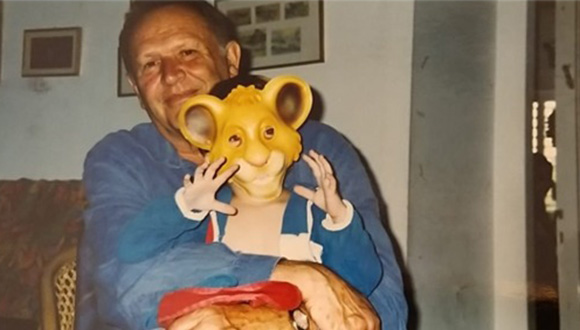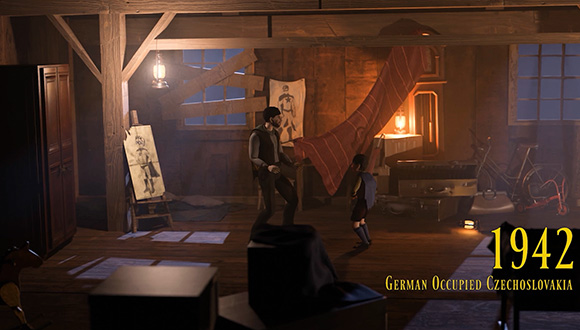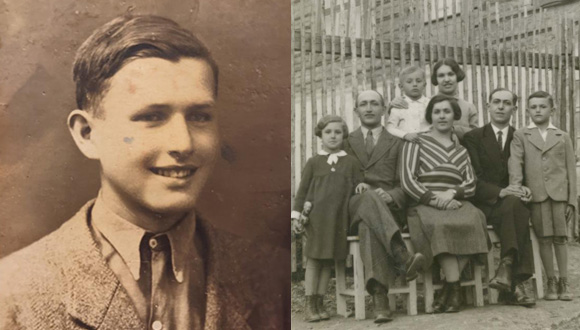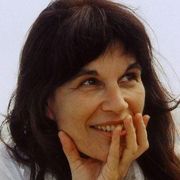How Do We Commemorate the Holocaust in 2024?
A Graduate of the Digital Media Track Created A Video Game Based on His Grandfather's Survival Story During the Holocaust as A Child.
Ohad Tadmor, a graduate of the Steve Tisch School of Film and Television and a digital media track alum, created a video game that not only entertains but also educates players about his grandfather's Holocaust survival. This innovative approach revitalizes the crucial mission of transmitting Holocaust memory to new audiences.
"I wanted to create a game that I would want to play, experience, and be moved by."
Ohad, tell us about the idea of turning your grandfather's story into a computer game.
"As a third generation Holocaust survivor, the subject very present in our family. The story of my grandfather, Abraham Avraham Hartzook, may he rest in peace, who survived the Holocaust alone as a child in the forests of Czechoslovakia, seemed like a suitable and unique template for a game that combines history, creativity, fear, danger, and courage. It has all the elements of a good story and in my opinion, a good story is one of the most meaningful factors in video games. Despite the sensitivity of the topic, I wanted to use this medium to bridge the gap in Holocaust remembrance among younger generations."

Ohad and his grandfather, Abraham Avraham Hartzook, may he rest in peace.
Which tools did your Film and Television degree, especially the Digital Media program, bring to your creative process?
"Throughout my life, I've been playing video games, but I never created one. During my studies, I immersed myself in game development software. We learned techniques in areas such as coding, animation, 3D modeling, lighting, and stage design, which helped me independently build the framework for an experience and understand how a general video game system operates.
"The narrative aspect was very important to me, and thankfully, during our studies, we also received personal guidance in developing a script for our creations. It was challenging because, unlike in films, a video game is interactive, and I had to think about how to adapt personal narratives into a unique interactive experience."
Who's the game's main audience?
the game is in actuality aimed towards girls and boys aged 12 and up who are into story-driven video games. But I can say that a lot of people with no prior gaming experience got really excited about it."
Do you think children living abroad could also identify with it and enjoy it?
"Of course, many players from around the world have played the game, and the message of resilience and coping resonates universally. Additionally, the game has no text, so it contributes to its accessibility from anywhere and at any age."
What emotional and gameplay experience awaits players?
"First and foremost, there's empathy for Emil (our avatar), along with feelings of fear, danger, creativity, resilience, and hope. These are the exact emotions I recall feeling myself when I listened to my grandfather's testimony, and they're what inspired me to craft this gaming experience. In terms of gameplay, I aimed to create a challenging and true-to-life experience."

A scene from the game 'Emil: A Hero's journey'.
Are there parts of Grandpa's testimony integrated into the game?
"Of course. The fantastical elements are products of our imagination, but many segments of the game are based on his testimony. One example is the gameplay section where Emil has to hide from soldiers' flashlights while concealing himself in a wheat field. When the Germans came to take his family to the camps, my grandfather, being the eldest among his siblings, leaped from the house window to the wheat field and hid there until they left. that’s what his father commanded him to do, believing he could survive on his own.
"Another example is that since there's no text in the game, I utilized the environment itself to tell the story (Environmental Storytelling). In the forest Emil traverses, you can see scattered Jewish belongings such as suitcases, carts, and photo albums. On one of the albums displayed prominently, you can see the real photos of my grandfather's lost family - his father, mother, sister, and little brother."

On the right: The Avraham Hartzook family, who perished in the Holocaust (Abraham, the survivor, is the rightmost child). On the left: Abraham Avraham Hartzook in his youth.
"I believe my grandfather would have been surprised to see a video game tackling this topic... but I think he would have understood that to reach today's young audience, adaptations in the medium are necessary."
Was the animation process of the child mainly technical, or did emotions take over?
"The process was quite complex. Since I wanted Emil's movements to be authentic and as similar as possible to those of a small, frightened child wandering alone in the forest, we brought an 11-year-old child actor named Yoav to portray Emil. Training Yoav on the character and his story, and on the game itself, wasn't easy and required a lot of sensitivity, especially when tackling a topic like the Holocaust, and certainly trying to integrate it into an emotional-conscious state that my grandfather experienced. Thankfully, Yoav is a sensitive and talented child, and based on his movements, we created those of Emil's 3D character.
The music accompanying the game is deeply emotional (string instruments), and actually reminiscent of Holocaust films. How did you caft it? Did you expect it to be Emil's accompanying sounds?
"The music accompanying the game is something I'm very proud of. I've always wanted to be a musician, and I truly believe that music is a significant part of an experience and can convey a lot of emotion. In creating the original soundtrack, I worked with a talented composer named Yotam Aloof, and we discussed the period, the story's essence, and the important feelings I wanted to emphasize through the melody. Of course, we also referenced a lot of tunes from various genres. Yotam composed and played the soundtrack on the piano, and then we recorded a live cello in the studio to accentuate the string instruments characteristic of Jewish music from that period.
What would your grandfather say if he could see and play the game?
"Grandmother Debby, my grandfather's widow, said that Grandpa would have been very proud knowing that his grandson is sharing his story and using it to commemorate the memory of the Holocaust, something he and other children his age endured. Personally, I believe my grandfather would have been surprised to see a video game about this topic, but with a deep and thorough explanation, I think he would understand that to reach today's young audience, adjustments in the medium are necessary, and as long as it's done with respect and awareness, it's a blessing.
Do you have any advice for someone considering enrolling in the Digital Media program?
Since the Digital Media track provides a wide range of tools in a comprehensive way, I would recommend anyone considering enrolling to try and understand what it's about. Whether they want to specialize or work in it in the future, in combination with cinema studies, this track offers a background and general understanding that can greatly assist in building our world, story, and design of our experience, as well as tools in programming, animation, and creating effects. Moreover, like any degree, I found myself learning and researching many topics independently and not waiting to study them only when required to do so in homework assignments."
The team that worked with Ohad on this meaningful project:
- Afik Yaari - Producer
- Or Hadir - Animation and 3D
- Nadav Litver - Programming
- Shachar Amiri - Concept Art
- Yotam Aloof - Music Composition
- Naor Hazan - Sound Design





